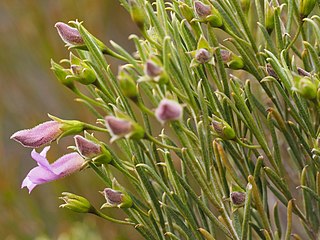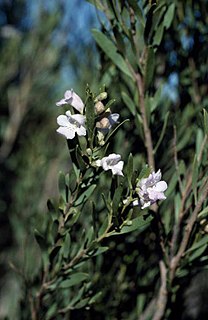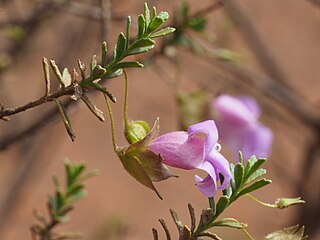
Eremophila freelingii, commonly known as limestone fuchsia or rock fuchsia bush, is a flowering plant in the figwort family, Scrophulariaceae and is endemic to Australia. It is a shrub with sticky, hairy, lance-shaped leaves and flowers a shade of light to dark lilac and which occurs in Queensland, New South Wales and South Australia.

Eremophila complanata is a flowering plant in the figwort family, Scrophulariaceae and is endemic to a small area in the south west of Western Australia. It is an erect shrub with narrow, flattened leaves and hairy pink flowers which are also distinctly flattened.
Eremophila elderi, commonly known as aromatic emu bush, is a flowering plant in the figwort family, Scrophulariaceae. It is endemic to central Australia where it grows near the border between Western Australia, South Australia and the Northern Territory. It is an erect, aromatic shrub with sticky leaves and branches and usually pale coloured to white flowers. Its specific epithet (elderi) honours an early Australian businessman, Thomas Elder.

Eremophila labrosa is a flowering plant in the figwort family, Scrophulariaceae and is endemic to Western Australia. It is a shrub with many hairy branches arising from near ground level, narrow, hooked leaves and mauve and blue flowers.

Eremophila lanceolata is a flowering plant in the figwort family, Scrophulariaceae and is endemic to Western Australia. It is a low, spreading shrub with foliage which is shiny when young, angular branches and lilac to purple flowers and which grows in the north-west of Western Australia.

Eremophila linearis, commonly known as harlequin fuchsia bush, is a flowering plant in the figwort family, Scrophulariaceae and is endemic to Western Australia. It is a shrub with long leaves, sticky, shiny leaves and branches and bright red flowers

Eremophila paisleyi is a plant in the figwort family, Scrophulariaceae and is endemic to Australia. It is a rounded, broom-shaped shrub with white or lilac-coloured flowers which occurs in Western Australia, South Australia and the Northern Territory.
Eremophila papillata is a flowering plant in the figwort family, Scrophulariaceae and is endemic to Western Australia. It is an erect, compact shrub with sticky, narrow leaves and mauve, blue or purple, rarely white flowers.
Eremophila pendulina is a flowering plant in the figwort family, Scrophulariaceae and is endemic to Western Australia. It is a tall, spindly, weeping shrub with narrow leaves and purple, mauve or white flowers in autumn and early spring.
Eremophila petrophila is a flowering plant in the figwort family, Scrophulariaceae and is endemic to Western Australia. It is a tall, erect, open shrub with rough branches, narrow, sticky leaves and pale lilac-coloured flowers.

Eremophila phyllopoda is a flowering plant in the figwort family, Scrophulariaceae and is endemic to Western Australia. It is an erect or spreading shrub, sometimes round or flat-topped with sticky, hairy leaves and flowers ranging in colour from pink or lilac to purple.
Eremophila prolata is a flowering plant in the figwort family, Scrophulariaceae and is endemic to Western Australia. It is an erect shrub with a rounded top, prominently ridged, hairy branches, narrow leaves and white to deep lilac-coloured flowers.

Eremophila punctata is a flowering plant in the figwort family, Scrophulariaceae and is endemic to Western Australia. It is an erect shrub with sticky young branches and leaves due to the presence of resin. Its small leaves usually have a few blunt teeth near their ends and flowers which are usually lilac-coloured. It is a distinctive and widespread species.
Eremophila pungens is a flowering plant in the figwort family, Scrophulariaceae and is endemic to Australia. It is an erect, sticky shrub with broad, serrated-edged leaves which end in a sharp spine and purple or violet flowers.

Eremophila reticulata is a flowering plant in the figwort family, Scrophulariaceae and is endemic to Western Australia. It is a dense shrub with egg-shaped leaves, colourful sepals and white or pink flowers.
Eremophila simulans is a flowering plant in the figwort family, Scrophulariaceae and is endemic to Western Australia. It is an erect shrub with broad, serrated leaves and violet to purple flowers.

Eremophila spectabilis, commonly known as showy poverty bush, is a flowering plant in the figwort family, Scrophulariaceae and is endemic to Western Australia. It is a dense, erect shrub with narrow, greyish leaves and blue, mauve or purple flowers.

Eremophila spuria is a flowering plant in the figwort family, Scrophulariaceae and is endemic to Western Australia. It is an erect, open shrub with narrow leaves and blue, lilac, purple or white flowers and is a common and widespread species.
Eremophila succinea is a flowering plant in the figwort family, Scrophulariaceae and is endemic to Western Australia. It is an erect, broom-shaped shrub with sticky, narrow, hooked leaves, narrow, sticky sepals and hairy, pale purple or mauve petals.
Eremophila viscimarginata is a flowering plant in the figwort family, Scrophulariaceae and is endemic to Western Australia. It is a small, erect, prickly shrub with hairy stems, small leaves, greenish-pink sepals and mauve petals.












